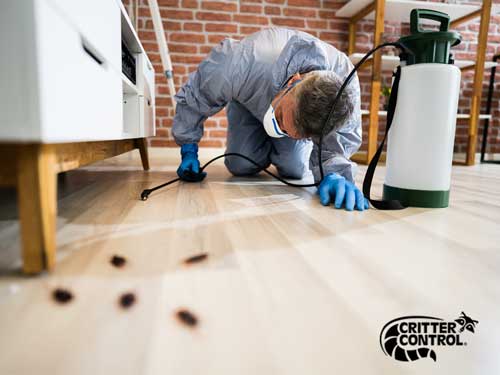A1 Bed Bug Exterminator Charlotte - Reliable and Budget-friendly Services
Bed Insect Therapy Break Down: Comparing Chemical Vs. Non-Chemical Solutions
In the world of pest control, particularly when dealing with the persistent problem of bed pests, the choice between chemical and non-chemical treatment remedies can be an essential one. Both methods use distinctive advantages and drawbacks, influencing variables such as efficiency, security considerations, and overall cost. By checking out the nuanced information of each technique, a more clear understanding of which course to pursue in attending to a bed pest infestation can be obtained.
Efficiency of Chemical Therapies
Chemical therapies for bed pest infestations have been widely recognized for their powerful and fast efficiency in getting rid of these parasites. When taking into consideration the effectiveness of chemical therapies, it is essential to understand that they can supply a fast and detailed remedy to a bed bug problem. Professional pest control operators often depend on insecticides to target bed insects at various phases of their life cycle, consisting of eggs, grownups, and nymphs. These chemicals normally function by disrupting the bed bugs' nerves, bring about paralysis and eventual death.
Moreover, chemical therapies have the advantage of supplying residual results, suggesting that they can remain to remove bed bugs also after the first application. This residual activity is especially helpful in combating any type of prospective re-infestations. In addition, the fast activity of chemical therapies can bring alleviation to individuals encountering severe bed insect infestations, enabling them to reclaim control of their living rooms promptly.
Security Worry About Chemical Solutions
When making use of chemical services for bed pest treatment is guaranteeing the security of passengers and the atmosphere,One important element that requires careful factor to consider. While chemical treatments can be reliable in eliminating bed pests, they might posture threats otherwise handled correctly. Among the main security interest in chemical options is the possible injury they can create to human wellness. Direct exposure to specific chemicals utilized in bed pest therapies can cause respiratory system issues, skin inflammation, or various other unfavorable reactions, particularly in individuals with pre-existing conditions or level of sensitivities. Furthermore, inappropriate application or dose of chemical pesticides can lead to harmful deposits lingering in the cured location, posing lasting wellness dangers to residents.
In addition, the environmental influence of chemical solutions is one more significant consideration. Some pesticides utilized in bed insect therapies may be harmful to valuable pests, wildlife, and environments if they seep into the soil or water systems. It is essential to use chemical therapies deliberately, following security guidelines, and thinking about much less poisonous alternatives to minimize these risks and make sure the secure and efficient administration of bed insect problems.
Advantages of Non-Chemical Strategies
Thinking about the prospective security issues and ecological effect associated with chemical solutions for bed bug treatment, discovering non-chemical methods presents an encouraging choice with a number of distinct advantages. Non-chemical treatments are environmentally friendly, as they do not add to air or water contamination, making them a lasting selection for parasite control.
Furthermore, non-chemical solutions can be efficient in targeting bed bugs, including hard-to-reach areas where chemical therapies may not penetrate - A1 exterminator charlotte nc. Methods such as heat therapy, vacuuming, vapor cleansing, and cushion coverings provide complete eradication without the use of damaging chemicals.
Limitations of Non-Chemical Treatments

Additionally, non-chemical treatments commonly call for several applications to achieve effective Click This Link obliteration. This can be lengthy and might not always ensure full removal of all bed pests and their eggs, specifically in covert or hard-to-reach places.
In addition, the success of non-chemical treatments greatly relies upon appropriate execution and thoroughness, which can be testing for individuals without expert experience. Inadequate application of non-chemical methods may lead to incomplete eradication, resulting in consistent invasions and the requirement for added treatments.
For that reason, while non-chemical treatments have their advantages, it is vital to acknowledge these constraints and consider them when determining the most effective approach for managing bed pest infestations.
Cost Contrast: Chemical Vs. Non-Chemical Options
Offered the constraints linked with non-chemical treatments, an important aspect to evaluate in the context of bed pest monitoring is the expense contrast between chemical and non-chemical alternatives. Chemical treatments generally include the application of insecticides by professionals, which can vary from $250 to $900 per space, depending upon the extent of the infestation and the dimension of the area to be treated. On the other hand, non-chemical treatments like heat therapy or heavy steam can be more pricey, with prices varying from $1,000 to $6,000 for an entire home. While the initial price of chemical treatments might seem reduced, multiple treatments might be called for to totally remove the infestation, possibly enhancing the total price. On the other hand, non-chemical alternatives may provide a much more sustainable and green service, although they can be cost-prohibitive for some individuals. Eventually, when taking into consideration the cost of bed pest treatment options, it is necessary to weigh the upfront expenses against the performance and long-lasting sustainability of the chosen approach.
Conclusion

Considering the prospective safety and security concerns and ecological influence associated with chemical options for bed pest therapy, exploring non-chemical approaches offers a promising option with a number of unique advantages.Provided the limitations associated with non-chemical treatments, an essential element to examine in the context of bed pest administration is the expense contrast in between chemical and non-chemical alternatives. In comparison, non-chemical therapies like warmth therapy or heavy steam can be more expensive, with costs ranging from $1,000 to $6,000 for an entire home. While the preliminary expense of chemical treatments may appear reduced, numerous therapies might be called for to totally remove the invasion, potentially enhancing the total cost.In conclusion, when comparing chemical and non-chemical bed insect treatment choices, it is crucial to think about efficiency, security, benefits, limitations, and cost.